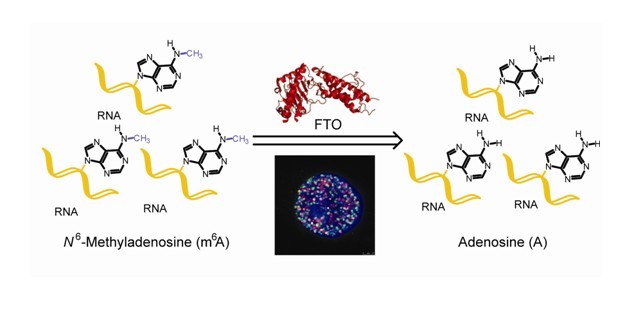N6-Methyladenosine in nuclear RNA is a major substrate of the obesity-associated FTO
A collaborative study, conducted in the laboratory of professor YANG Yungui from Beijing Institute of Genomics (BIG), Chinese Academy of Sciences (CAS), and the laboratory of professor HE Chuan from University of Chicago, for the first time revealed that N6-Methyladenosine (m6A) in mammalian mRNAs is oxidatively demethylated in vitro and inside cells by the major obesity susceptibility gene FTO (fat mass and obesity-associated protein).
Obesity has become a severe world-wide public health concern. FTO protein has been shown to affect human obesity and energy homeostasis. Since the first connection with obesity was made through genome-wide association studies, FTO has become a prominent target of research in the field. However, the physiological substrate and function of FTO remains unknown, which prevents understanding of the mechanism and pathway of the FTO-mediated regulation at molecular level.
Yang and colleagues proved that FTO has efficient oxidative demethylation activity targeting the abundant m6A residues in RNA in vitro. FTO knockdown with siRNA led to increased amounts of m6A in mRNAs, whereas overexpression of FTO resulted in decreased amounts of m6A in human cells. Further study shows the partial colocalization of FTO with nuclear speckles, supporting the notion that m6A in nuclear RNAs is a major physiological substrate of FTO. This study suggests a new mode of biological regulation through reversible RNA methylation in mammalian cells.
The research results were published online in Nature Chemical Biology on October 16, 2011. Ms. ZHAO Xu as a Ph.D. candidate supervised by prof. YANG Yungui shares co-first authorship.

N6-methyladenosine (m6A) in mammalian mRNA is oxidatively demethylated by fat mass and obesity-associated protein (FTO),a major obesity factor. The partial colocalization of FTO with nuclear speckles supports the notion that m6A in nuclear RNAs is a critical physiological substrate of FTO. (Image Courtesy from Nature Chemical Biology)
Paper link: http://www.nature.com/nchembio/journal/vaop/ncurrent/full/nchembio.687.html
Contact: Prof. YANG Yungui ygyang@big.ac.cn